RENAULT KOLEOS 2012 1.G Owners Manual
Manufacturer: RENAULT, Model Year: 2012, Model line: KOLEOS, Model: RENAULT KOLEOS 2012 1.GPages: 233, PDF Size: 7.81 MB
Page 101 of 233
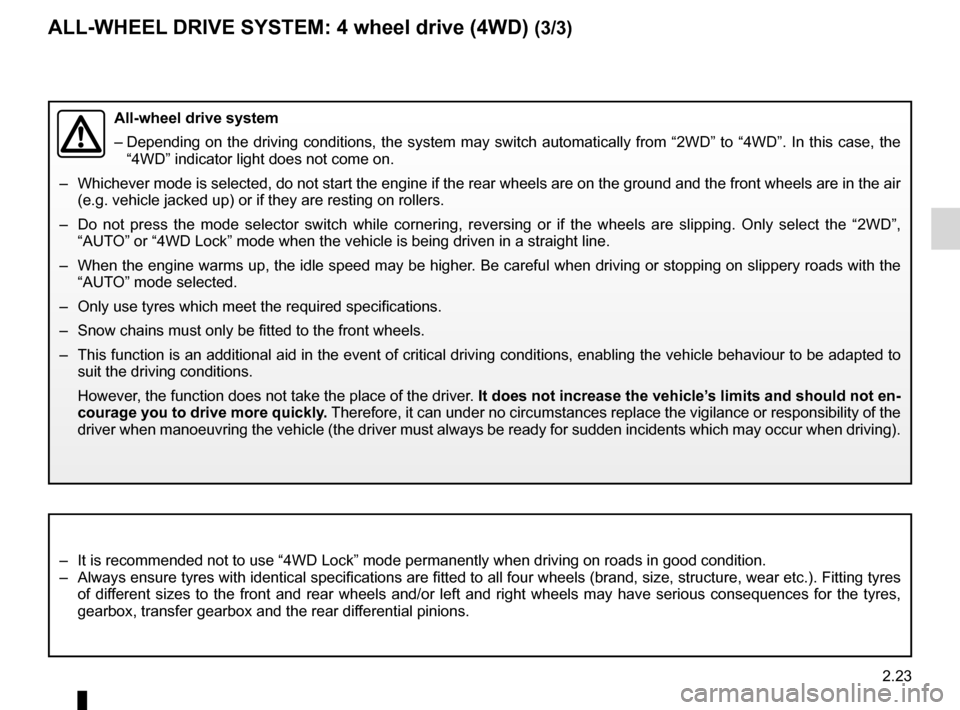
JauneNoirNoir texte
2.23
ENG_UD27290_7
Transmission int grale : 4 roues motrices : 4WD (X45 - H45 - Renault)
ENG_NU_977-2_H45_Ph2_Renault_2
ALL-wHEEL DRIvE SYSTEM: 4 wheel drive (4wD) (3/3)
All-wheel drive system
– Depending on the driving conditions, the system may switch automatically from “2WD” to “4WD”. In this case, the
“4WD” indicator light does not come on.
– Whichever mode is selected, do not start the engine if the rear wheels are on the ground and the front wheels are in the air
(e.g. vehicle jacked up) or if they are resting on rollers.
– Do not press the mode selector switch while cornering, reversing or if the wheels are slipping. Only select the “2WD”,
“AUTO” or “4WD Lock” mode when the vehicle is being driven in a straight line.
– When the engine warms up, the idle speed may be higher. Be careful when driving or stopping on slippery roads with the
“AUTO” mode selected.
– Only use tyres which meet the required specifications.
– Snow chains must only be fitted to the front wheels.
– This function is an additional aid in the event of critical driving conditions, enabling the vehicle behaviour to be adapted to
suit the driving conditions.
However, the function does not take the place of the driver. It does not increase the vehicle’s limits and should not en-
courage you to drive more quickly. Therefore, it can under no circumstances replace the vigilance or responsibility of the
driver when manoeuvring the vehicle (the driver must always be ready for sudden incidents which may occur when driving).
– It is recommended not to use “4WD Lock” mode permanently when driving on roads in good condition.
– Always ensure tyres with identical specifications are fitted to all four wheels (brand, size, structure, wear etc.). Fitting tyres
of different sizes to the front and rear wheels and/or left and right wheels may have serious consequences for the tyres,
gearbox, transfer gearbox and the rear differential pinions.
Page 102 of 233
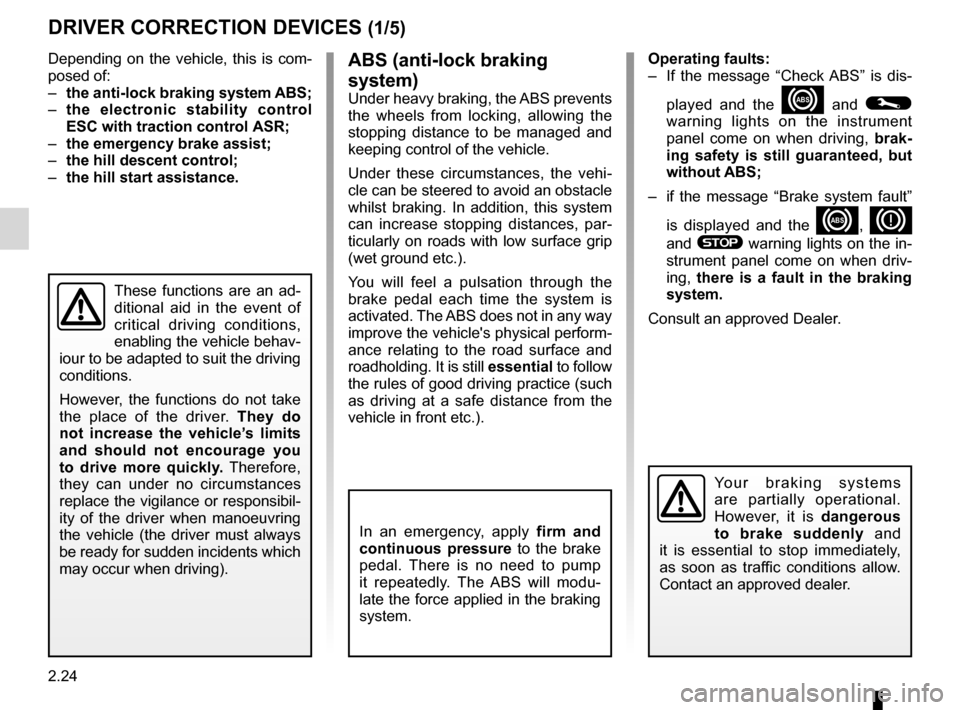
ESP: Electronic Stability Program ........ (up to the end of the DU)
ABS ...................................................... (up to the end of the DU)
anti-lock braking system: ABS ..............(up to the end of the DU)
Electronic Stability Program: ESP ........ (up to the end of the DU)
driving ................................................... (up to the end of the DU)
2.24
ENG_UD27148_7
Dispositifs de correction et d’assistance la conduite (X45 - H45 - Renault)
ENG_NU_977-2_H45_Ph2_Renault_2
Jaune NoirNoir texte
Driver correction devices
DRIvER CORRECTION DEvICES (1/5)
Depending on the vehicle, this is com-
posed of:
– the anti-lock braking system ABS;
– the electronic stability control
ESC with traction control ASR;
– the emergency brake assist;
– the hill descent control;
– the hill start assistance. Operating faults:
–
If the message “ Check ABS” is dis-
played and the
x and ©
warning lights on the instrument
panel come on when driving, brak-
ing safety is still guaranteed, but
without ABS;
– if the message “Brake system fault”
is displayed and the
x, D
and
® warning lights on the in-
strument panel come on when driv -
ing, there is a fault in the braking
system.
Consult an approved Dealer.
These functions are an ad-
ditional aid in the event of
critical driving conditions,
enabling the vehicle behav -
iour to be adapted to suit the driving
conditions.
However, the functions do not take
the place of the driver. They do
not increase the vehicle’s limits
and should not encourage you
to drive more quickly. Therefore,
they can under no circumstances
replace the vigilance or responsibil -
ity of the driver when manoeuvring
the vehicle (the driver must always
be ready for sudden incidents which
may occur when driving).
ABS (anti-lock braking
system)
Under heavy braking, the ABS prevents
the wheels from locking, allowing the
stopping distance to be managed and
keeping control of the vehicle.
Under these circumstances, the vehi -
cle can be steered to avoid an obstacle
whilst braking. In addition, this system
can increase stopping distances, par -
ticularly on roads with low surface grip
(wet ground etc.).
You will feel a pulsation through the
brake pedal each time the system is
activated. The ABS does not in any way
improve the vehicle's physical perform-
ance relating to the road surface and
roadholding. It is still essential to follow
the rules of good driving practice (such
as driving at a safe distance from the
vehicle in front etc.).
In an emergency, apply firm and
continuous pressure to the brake
pedal. There is no need to pump
it repeatedly. The ABS will modu -
late the force applied in the braking
system.
Yo u r b r a k i n g s y s t e m s
are partially operational.
However, it is dangerous
to brake suddenly and
it is essential to stop immediately,
as soon as traffic conditions allow.
Contact an approved dealer.
Page 103 of 233
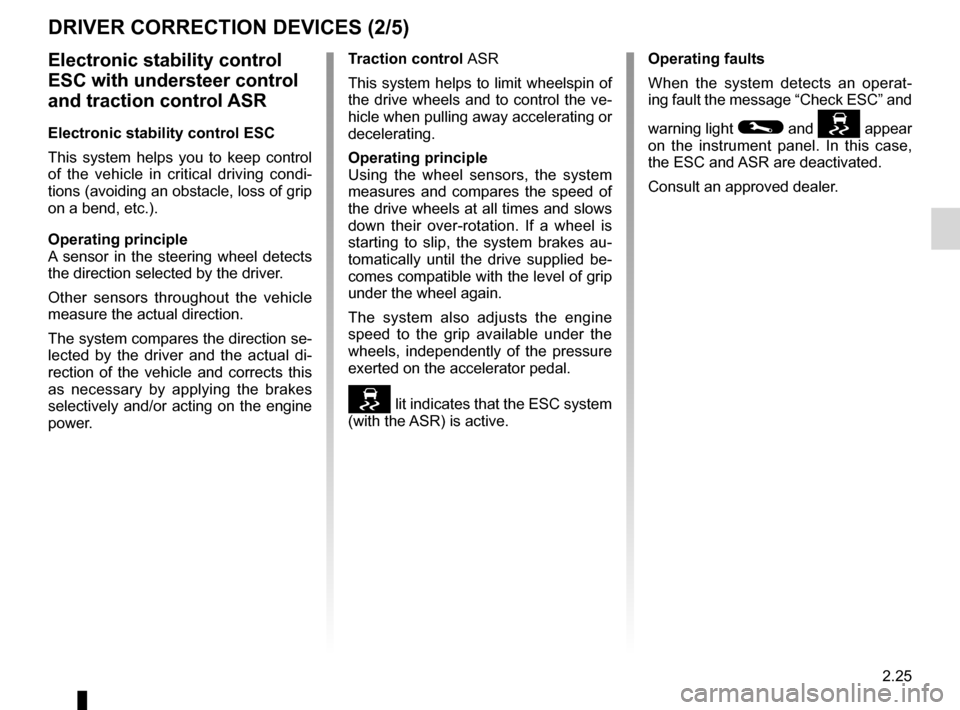
JauneNoirNoir texte
2.25
ENG_UD27148_7
Dispositifs de correction et d’assistance la conduite (X45 - H45 - Renault)
ENG_NU_977-2_H45_Ph2_Renault_2
DRIvER CORRECTION DEvICES (2/5)
Electronic stability control
ESC with understeer control
and traction control ASR
Electronic stability control ESC
This system helps you to keep control
of the vehicle in critical driving condi -
tions (avoiding an obstacle, loss of grip
on a bend, etc.).
Operating principle
A sensor in the steering wheel detects
the direction selected by the driver.
Other sensors throughout the vehicle
measure the actual direction.
The system compares the direction se-
lected by the driver and the actual di -
rection of the vehicle and corrects this
as necessary by applying the brakes
selectively and/or acting on the engine
power. Traction control
ASR
This system helps to limit wheelspin of
the drive wheels and to control the ve-
hicle when pulling away accelerating or
decelerating.
Operating principle
Using the wheel sensors, the system
measures and compares the speed of
the drive wheels at all times and slows
down their over-rotation. If a wheel is
starting to slip, the system brakes au -
tomatically until the drive supplied be -
comes compatible with the level of grip
under the wheel again.
The system also adjusts the engine
speed to the grip available under the
wheels, independently of the pressure
exerted on the accelerator pedal.
lit indicates that the ESC system
(with the ASR) is active. Operating faults
When the system detects an operat
-
ing fault the message “Check ESC” and
warning light
© and appear
on the instrument panel. In this case,
the ESC and ASR are deactivated.
Consult an approved dealer.
Page 104 of 233

2.26
ENG_UD27148_7
Dispositifs de correction et d’assistance la conduite (X45 - H45 - Renault)
ENG_NU_977-2_H45_Ph2_Renault_2
Jaune NoirNoir texte
DRIvER CORRECTION DEvICES (3/5)
If you deactivate this function, the
traction control (ASR) system will
also be deactivated.
As the ESC and ASR provide enhanced
safety, it is not advisable to drive with
the function switched off. Correct
this as soon as possible by pressing
switch 1 again.
Note: the system is automatically reac-
tivated each time the engine is switched
off.
1
Disabling the ESC function
(including traction control (ASR)
system)
In some situations (driving on very wet
ground: snow, mud, etc. or driving with
snow chains fitted), the system may
reduce the engine output to limit wheel -
spin. If this is not required, it is possible
to deactivate the function by pressing
switch 1.
The message “ESC off” is displayed on
the instrument panel to inform you.
Emergency brake assist
This system supplements the ABS
and helps reduce vehicle stopping dis-
tances.
Operating principle
Depending on the speed at which the
brake pedal is depressed, the system
will detect emergency braking. In this
case, the braking assistance immedi -
ately develops maximum power and
may trigger ABS regulation.
ABS braking is maintained as long as
the brake pedal is applied.
Hazard warning lights switching on
Depending on the vehicle, these may
light up in the event of sudden decel -
eration.
Page 105 of 233
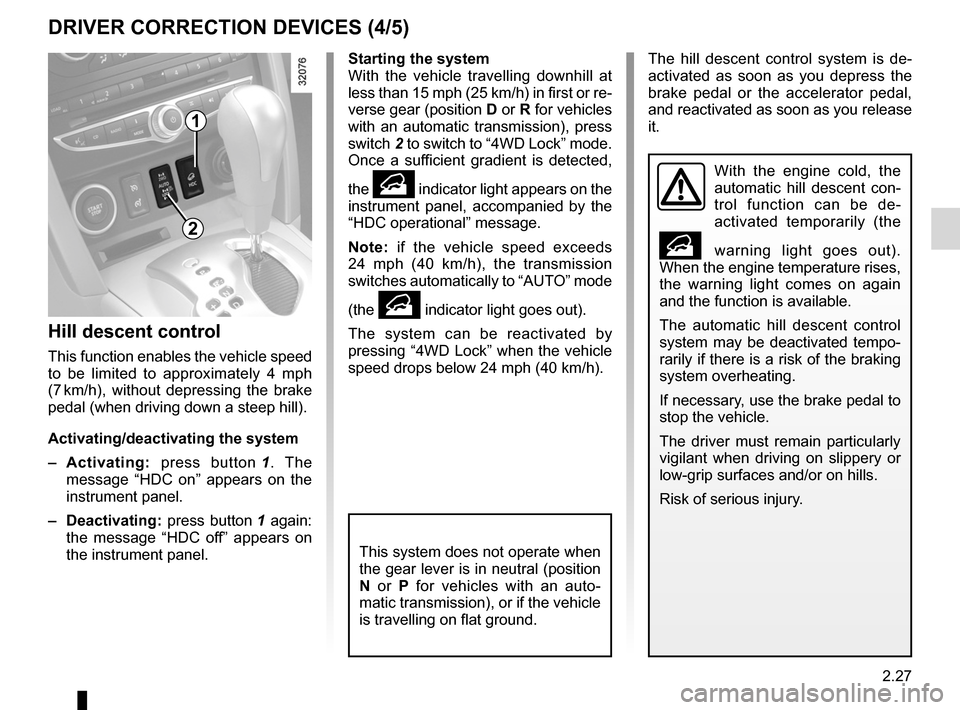
downhill speed control ........................................... (current page)
JauneNoirNoir texte
2.27
ENG_UD27148_7
Dispositifs de correction et d’assistance la conduite (X45 - H45 - Renault)
ENG_NU_977-2_H45_Ph2_Renault_2
DRIvER CORRECTION DEvICES (4/5)
Hill descent control
This function enables the vehicle speed
to be limited to approximately 4 mph
(7 km/h), without depressing the brake
pedal (when driving down a steep hill).
Activating/deactivating the system
– Activating: press button 1 . The
message “ HDC on” appears on the
instrument panel.
– Deactivating: press button 1 again:
the message “ HDC off” appears on
the instrument panel.
Starting the system
With the vehicle travelling downhill at
less than 15 mph (25 km/h) in first or re-
verse gear (position D or R for vehicles
with an automatic transmission), press
switch 2 to switch to “4WD Lock” mode.
Once a sufficient gradient is detected,
the
• indicator light appears on the
instrument panel, accompanied by the
“HDC operational ” message.
Note: if the vehicle speed exceeds
24 mph (40 km/h), the transmission
switches automatically to “AUTO” mode
(the
• indicator light goes out).
The system can be reactivated by
pressing “4WD Lock” when the vehicle
speed drops below 24 mph (40 km/h).
1
With the engine cold, the
automatic hill descent con -
trol function can be de -
activated temporarily (the
• warning light goes out).
When the engine temperature rises,
the warning light comes on again
and the function is available.
The automatic hill descent control
system may be deactivated tempo-
rarily if there is a risk of the braking
system overheating.
If necessary, use the brake pedal to
stop the vehicle.
The driver must remain particularly
vigilant when driving on slippery or
low-grip surfaces and/or on hills.
Risk of serious injury.
This system does not operate when
the gear lever is in neutral (position
N or P for vehicles with an auto -
matic transmission), or if the vehicle
is travelling on flat ground.
2
The hill descent control system is de -
activated as soon as you depress the
brake pedal or the accelerator pedal,
and reactivated as soon as you release
it.
Page 106 of 233
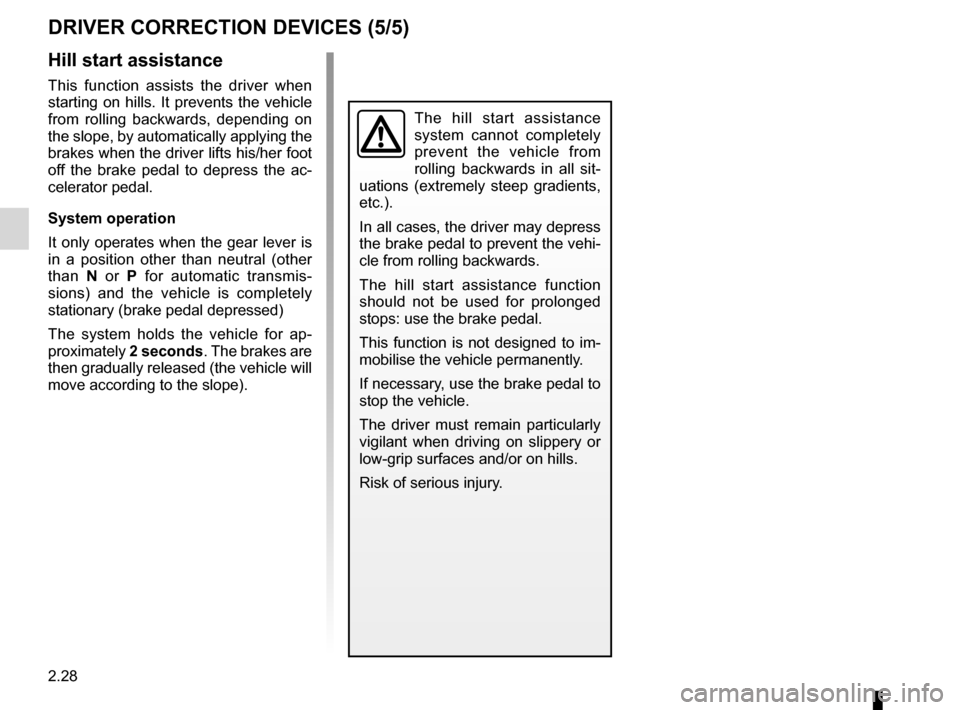
Hill Start Assistance (HSA) ....................................(current page)
hill start ................................................. (up to the end of the DU)
2.28
ENG_UD27148_7
Dispositifs de correction et d’assistance la conduite (X45 - H45 - Renault)
ENG_NU_977-2_H45_Ph2_Renault_2
DRIvER CORRECTION DEvICES (5/5)
Hill start assistance
This function assists the driver when
starting on hills. It prevents the vehicle
from rolling backwards, depending on
the slope, by automatically applying the
brakes when the driver lifts his/her foot
off the brake pedal to depress the ac -
celerator pedal.
System operation
It only operates when the gear lever is
in a position other than neutral (other
than N or P for automatic transmis -
sions) and the vehicle is completely
stationary (brake pedal depressed)
The system holds the vehicle for ap -
proximately 2 seconds. The brakes are
then gradually released (the vehicle will
move according to the slope).
The hill start assistance
system cannot completely
prevent the vehicle from
rolling backwards in all sit -
uations (extremely steep gradients,
etc.).
In all cases, the driver may depress
the brake pedal to prevent the vehi-
cle from rolling backwards.
The hill start assistance function
should not be used for prolonged
stops: use the brake pedal.
This function is not designed to im-
mobilise the vehicle permanently.
If necessary, use the brake pedal to
stop the vehicle.
The driver must remain particularly
vigilant when driving on slippery or
low-grip surfaces and/or on hills.
Risk of serious injury.
Page 107 of 233
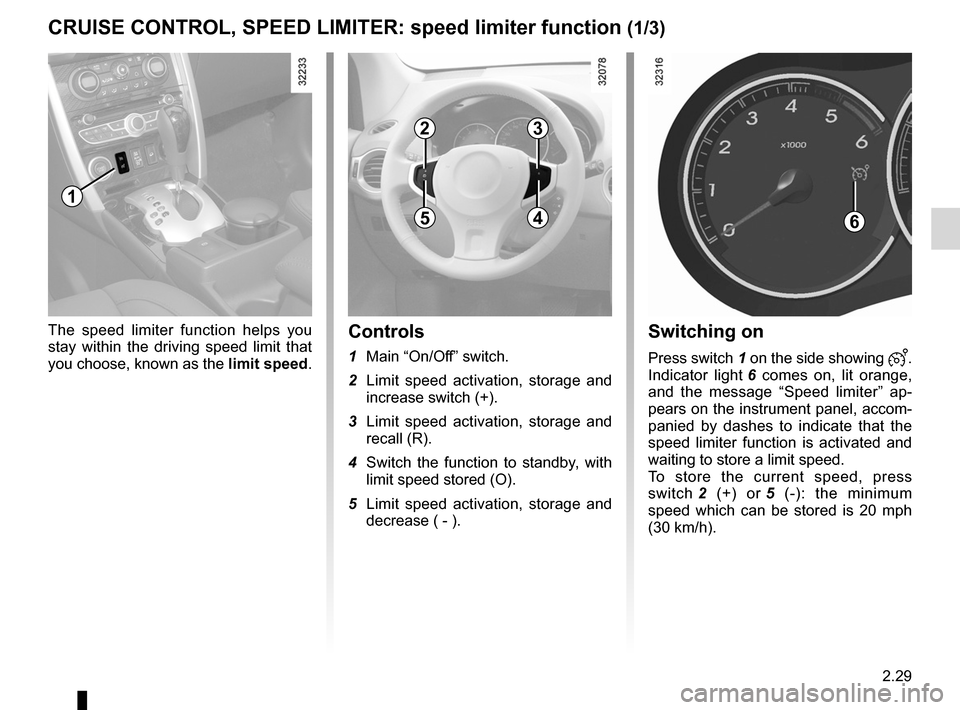
speed limiter ......................................... (up to the end of the DU)
cruise control-speed limiter................... (up to the end of the DU)
driving ................................................... (up to the end of the DU)
cruise control ........................................ (up to the end of the DU)
2.29
ENG_UD27291_6
R gulateur-limiteur de vitesse : fonction limiteur (X45 - H45 - Renault)
ENG_NU_977-2_H45_Ph2_Renault_2
Speed limiter
CRUISE CONTROL, SPEED LIMITER : speed limiter function (1/3)
Controls
1 Main “On/Off” switch.
2 Limit speed activation, storage and
increase switch (+).
3 Limit speed activation, storage and
recall (R).
4 Switch the function to standby, with
limit speed stored (O).
5 Limit speed activation, storage and
decrease ( - ).
1
2
5
3
46
The speed limiter function helps you
stay within the driving speed limit that
you choose, known as the limit speed.Switching on
Press switch 1 on the side showing .
Indicator light 6 comes on, lit orange,
and the message “ Speed limiter” ap-
pears on the instrument panel, accom-
panied by dashes to indicate that the
speed limiter function is activated and
waiting to store a limit speed.
To store the current speed, press
switch 2 (+) or 5 (-): the minimum
speed which can be stored is 20 mph
(30 km/h).
Page 108 of 233
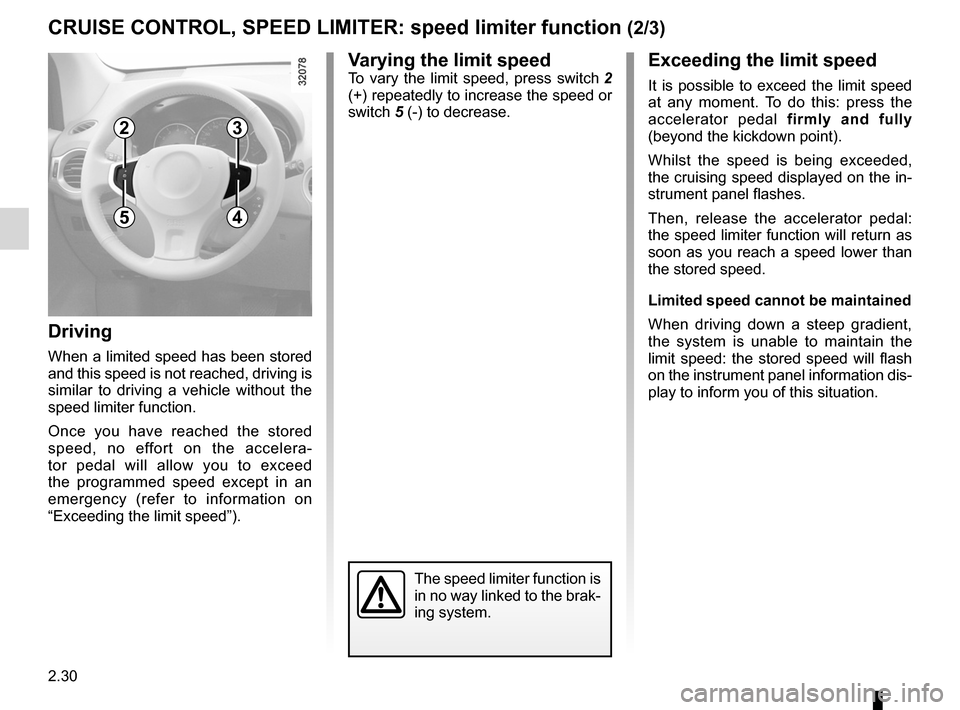
2.30
ENG_UD27291_6
R gulateur-limiteur de vitesse : fonction limiteur (X45 - H45 - Renault)
ENG_NU_977-2_H45_Ph2_Renault_2
Jaune NoirNoir texte
CRUISE CONTROL, SPEED LIMITER: speed limiter function (2/3)
2
5
3
4
Driving
When a limited speed has been stored
and this speed is not reached, driving is
similar to driving a vehicle without the
speed limiter function.
Once you have reached the stored
speed, no effort on the accelera -
tor pedal will allow you to exceed
the programmed speed except in an
emergency (refer to information on
“Exceeding the limit speed”).
Exceeding the limit speed
It is possible to exceed the limit speed
at any moment. To do this: press the
accelerator pedal firmly and fully
(beyond the kickdown point).
Whilst the speed is being exceeded,
the cruising speed displayed on the in-
strument panel flashes.
Then, release the accelerator pedal:
the speed limiter function will return as
soon as you reach a speed lower than
the stored speed.
Limited speed cannot be maintained
When driving down a steep gradient,
the system is unable to maintain the
limit speed: the stored speed will flash
on the instrument panel information dis-
play to inform you of this situation.
The speed limiter function is
in no way linked to the brak-
ing system.
v arying the limit speedTo vary the limit speed, press switch 2
(+) repeatedly to increase the speed or
switch 5 (-) to decrease.
Page 109 of 233
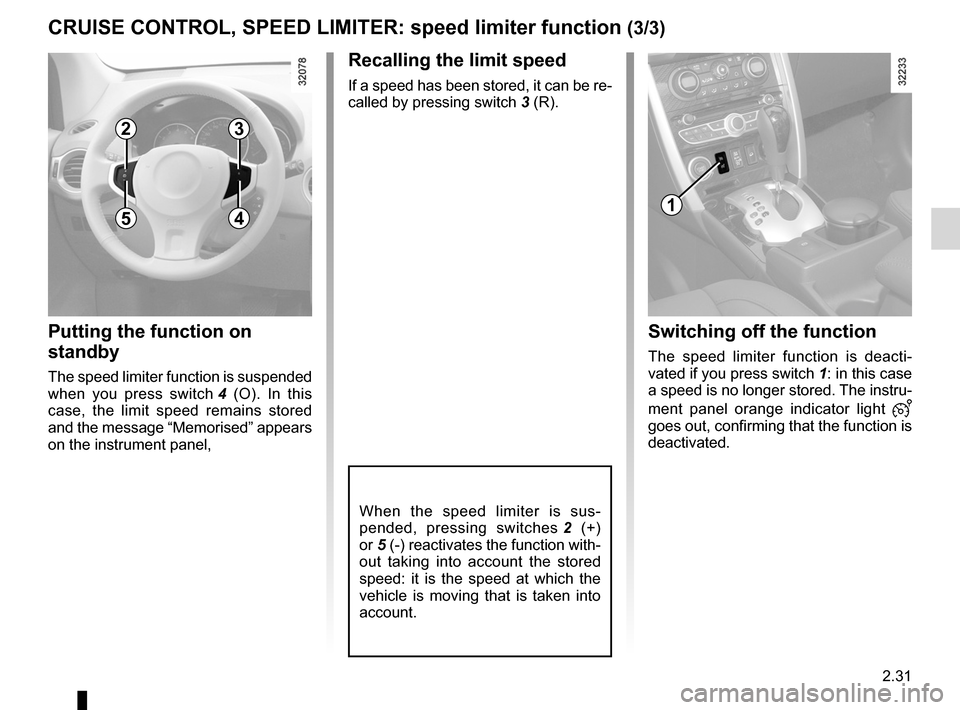
JauneNoirNoir texte
2.31
ENG_UD27291_6
R gulateur-limiteur de vitesse : fonction limiteur (X45 - H45 - Renault)
ENG_NU_977-2_H45_Ph2_Renault_2
CRUISE CONTROL, SPEED LIMITER: speed limiter function (3/3)
2
5
3
41
Putting the function on
standby
The speed limiter function is suspended
when you press switch 4 (O). In this
case, the limit speed remains stored
and the message “Memorised ” appears
on the instrument panel,
Recalling the limit speed
If a speed has been stored, it can be re-
called by pressing switch 3 (R).
When the speed limiter is sus -
pended, pressing switches 2 (+)
or 5 (-) reactivates the function with-
out taking into account the stored
speed: it is the speed at which the
vehicle is moving that is taken into
account.
Switching off the function
The speed limiter function is deacti -
vated if you press switch 1: in this case
a speed is no longer stored. The instru-
ment panel orange indicator light
goes out, confirming that the function is
deactivated.
Page 110 of 233
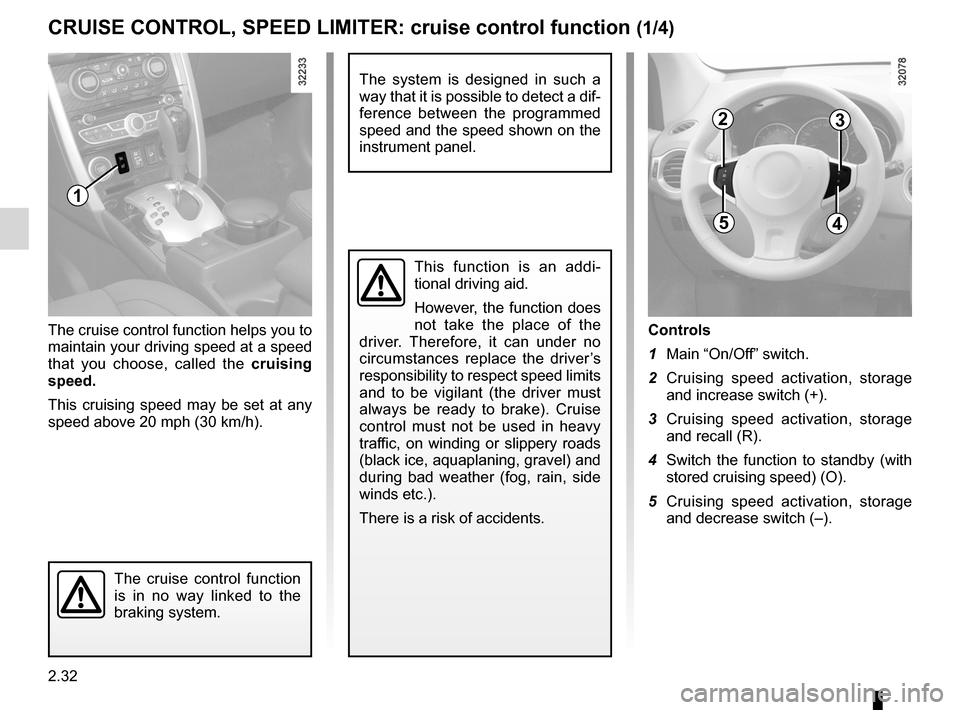
cruise control ........................................ (up to the end of the DU)
cruise control-speed limiter................... (up to the end of the DU)
driving ................................................... (up to the end of the DU)
2.32
ENG_UD23498_5
Régulateur-limiteur de vitesse : fonction régulateur (X45 - H45 - Renault)
ENG_NU_977-2_H45_Ph2_Renault_2
Jaune NoirNoir texte
Cruise control
Controls
1 Main “On/Off” switch.
2 Cruising speed activation, storage
and increase switch (+).
3 Cruising speed activation, storage
and recall (R).
4 Switch the function to standby (with
stored cruising speed) (O).
5 Cruising speed activation, storage
and decrease switch (–).
The cruise control function helps you to
maintain your driving speed at a speed
that you choose, called the
cruising
speed.
This cruising speed may be set at any
speed above 20 mph (30 km/h).
The cruise control function
is in no way linked to the
braking system.
This function is an addi -
tional driving aid.
However, the function does
not take the place of the
driver. Therefore, it can under no
circumstances replace the driver’s
responsibility to respect speed limits
and to be vigilant (the driver must
always be ready to brake). Cruise
control must not be used in heavy
traffic, on winding or slippery roads
(black ice, aquaplaning, gravel) and
during bad weather (fog, rain, side
winds etc.).
There is a risk of accidents.
CRUISE CONTROL, SPEED LIMITER: cruise control function (1/4)
1
23
45
The system is designed in such a
way that it is possible to detect a dif-
ference between the programmed
speed and the speed shown on the
instrument panel.